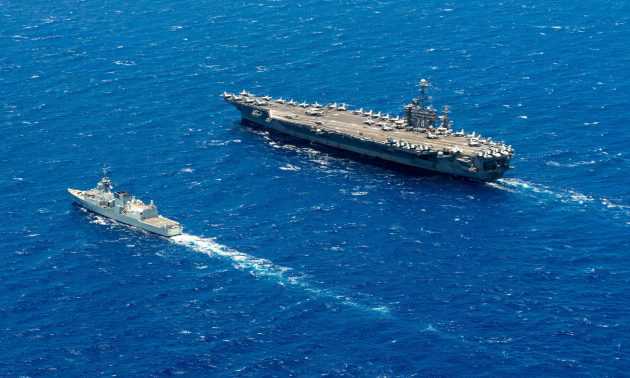Canada wary of challenging China on South China Sea
25 November, 2018

Canada’s naval engagement in the Western Pacific has grown considerably in the past two years, and warships waving the Maple Leaf flag are becoming a common sight in the troubled region. But despite its alliance with the United States, which is increasingly concerned with China’s militarization of the South China Sea, it is too much of a stretch to think that Ottawa is sending its navy there to challenge Beijing.
Commander Blair Saltel, commanding officer of the Canadian frigate HMCS Calgary, which is currently in East Asia supporting Operation Projection, has been reported to say that his country expects to send one or two ships to the area on a yearly basis. There is already speculation that Canada is ready to join US-sponsored Freedom of Navigation Operations (FONOPs) in the China seas.
Responding to a request for comment from Asia Times on the scope of Canada’s naval commitment to the Asia-Pacific region, the Canadian Department of National Defense said the Royal Canadian Navy was a globally deployed force that, in line with the country’s defense policy, worked on its own and in support of allies and partners to improve regional security and stability around the world.
Moreover, the department struck a careful tone regarding the disputed East and South China seas, where Beijing has conflicting claims with Japan, Taiwan and some Southeast Asian neighbors. It stressed that while “Canada supports the principles of freedom of navigation and overflight conducted in accordance with international law, including the rights of coastal states, it does not generally comment on foreign maritime boundaries or territorial disputes.”
In this respect, it is significant that Canada calls its Asia-Pacific deployments “presence patrols,” and does not use the term FONOP, noted Dave Perry, vice president of the Canadian Global Affairs Institute.
HMCS Calgary, along with the naval replenishment unit Asterix, was shadowed by Chinese warships last month while sailing through the South China Sea, which Beijing claims almost entirely. Canada’s Halifax-class frigate has so far held anti-submarine warfare exercises with US and Japanese vessels in the waters around Japan, and conducted multilateral operations to prevent ship-to-ship transfers in the East China Sea in violation of the sanctions regime imposed by the United Nations on North Korea.
The two Canadian ships followed the deployment of HMCS Vancouver from April to June 2018. They also made port visits in Australia and Vietnam, which are both critical of China’s military build-up in the South China Sea, as well as South Korea and the US territory of Guam, training with local naval forces.
“Consistent with the country’s defense strategy, the Royal Canadian Navy maintains a persistent presence in the Asia-Pacific,” Canadian defense officials insisted. They said this approach contributed to Canada’s objectives of joining the Association of Southeast Asian Nations (ASEAN) Defense Ministers’ Meeting-Plus, enhancing its participation in the ASEAN Regional Forum, contributing to security and stability on the Korean Peninsula and working with key partners on regional security issues.
But they also emphasized that the Canadian government aimed at developing defense ties with China. The Asian giant is Canada’s largest trading partner after the United States. On November 14, after a meeting in Singapore with his Chinese counterpart Li Keqiang, Canadian Prime Minister Justin Trudeau said his government would continue exploratory discussions towards a potential comprehensive trade agreement with China.
Canada’s relationship with China is likely to play an important part in the definition and implementation of the Trudeau administration’s maritime strategy. However, the biggest problem for Ottawa’s plans in this business remains its limited naval potential and the need to balance the distribution of forces between the Atlantic and Pacific sectors.
“The Canadian navy’s plan for the next couple of years is to send at least two ships to the region and to make that presence routine. For Canada’s current fleet of 12 frigates, two ships is a major share of our deployable fleet, so this is a significant contribution in Canada terms,” Perry admitted.
Canada’s prosperity depends on trade, so it has an interest in protecting sea lines of communication with fast-growing Asian countries. At the same time, however, the Canadian navy must support Northern Atlantic Treaty Organization’s operations in the Atlantic Ocean against a resurgent Russia, which is also a competitor in the Arctic area, where the melting ice is opening new shipping routes.
The Canadian government is working to modernize its surface combat fleet. It plans to replace the navy’s old frigates and retired destroyers with 15 next-generation sub hunters. The country’s frigate program is worth C$62 billion (US$49 billion) and should be completed in two decades starting from 2023.
Last month, Ottawa selected British BAE Systems’ Type 26 frigate as the preferred design for the procurement. The Type 26 has been proposed by a consortium of defense contractors led by Lockheed Martin Canada. The Canadian cabinet is expected to make a final decision by spring 2019.
The Type 26 has also been picked by Australia, which aims to construct nine modern anti-submarine frigates to beef up its naval deterrent against possible foreign intrusions (that is, against China’s) into its waters.
Despite the expected deployment of new frigates, the Department of National Defense pointed out to Asia Times that there were currently no plans to change the disposition of the Canadian fleet. Canada’s Pacific naval forces now consist of 14 vessels (five frigates, three submarines and six coastal defense units), excluding training and auxiliary ships.
“Canada future fleet of 15 surface combatants will be a multi-capability frigate/destroyer hybrid, with a sophisticated anti-submarine warfare capacity,” Perry explained. “Like the current fleet, they will be split unevenly between the Canadian west and east coasts, likely with one or two more based on the east side. They will be used globally, and there are no plans to focus them in only one part of the world.”
